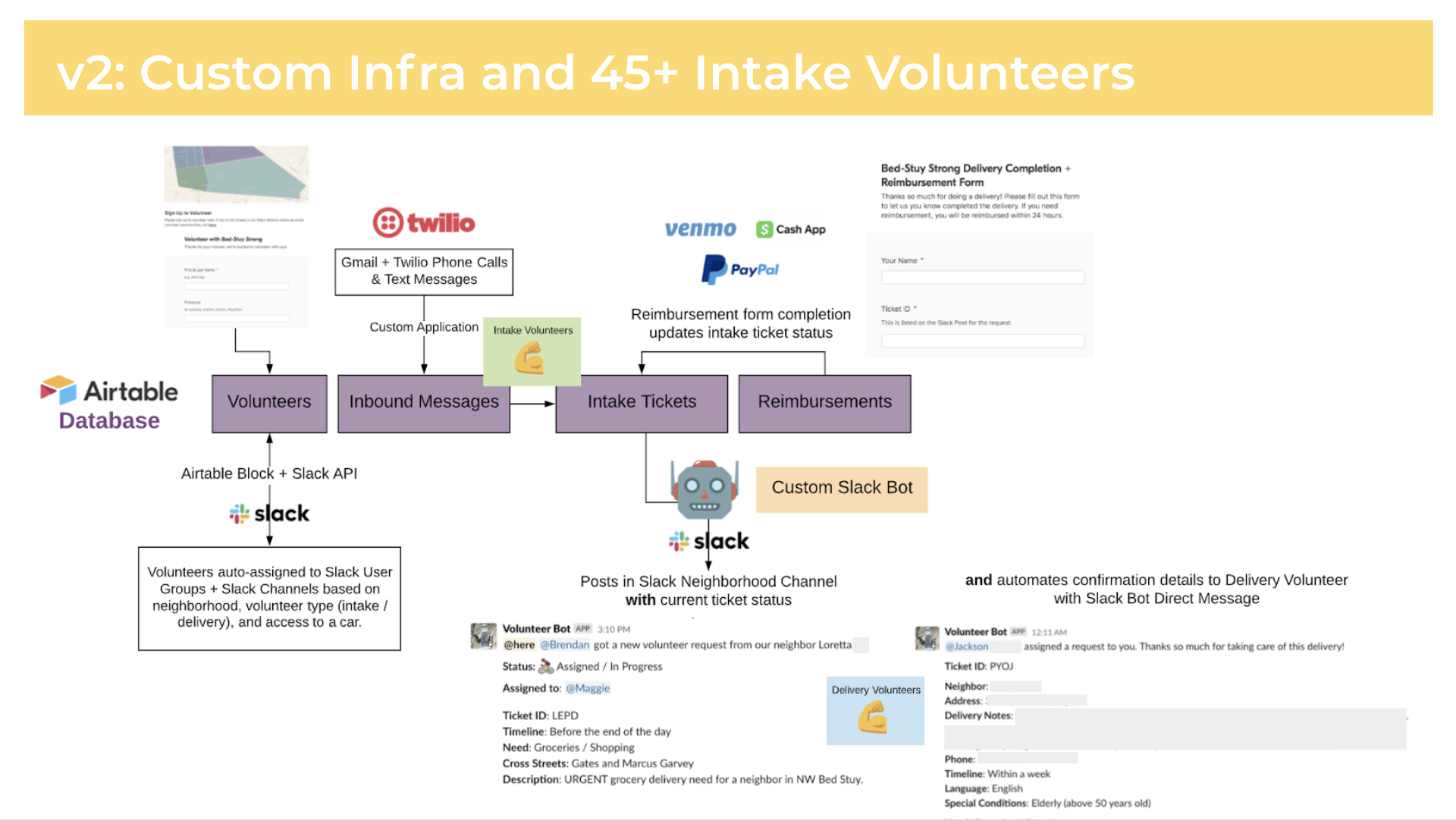As the epicenter of Covid-19 in the United States, New York City has quickly become one of the country’s largest hubs of mutual aid, redistributing food, medical supplies, and personal protective equipment to people in need during the crisis. Unlike charities, mutual aid efforts involve groups of people pooling their resources to help each other directly instead of waiting on assistance from governments, corporations, and other institutions.
These projects aren’t just fly-by-night operations. In the city’s boroughs and beyond, many have become high-tech engines of community support, powered by software platforms designed to distribute resources to the most vulnerable populations as quickly as possible—and most importantly, to help neighbors connect with one another during a period of isolation and uncertainty.
Virtually all the tech platforms we use on a daily basis were designed with profit-seeking business in mind, and more often than not, their usage reflects those intentions. But in response to Covid-19, mutual aid groups have begun using those platforms as a springboard for more robust systems designed entirely around helping and connecting people throughout the crisis.
In Brooklyn’s Bedford-Stuyvesant neighborhood, members of the mutual aid network Bed-Stuy Strong started by putting up flyers with their website and a Google Voice number, which residents could call to request free grocery deliveries. The calls, texts, and emails reach a group of intake volunteers, who contact neighbors to confirm requests and then forward the details via Slack to another group of volunteers who shop for food and make deliveries.
“Our tech makes us more efficient, but the foundation is this incredible culture of volunteerism, solidarity, and thoughtfulness,” Alyssa Dizon, a volunteer who manages the group’s automation system, told Motherboard. “None of these people are employees. The reason they show up is because they have a lot of heart and soul in the work.”
The system quickly reached its limits, and was revamped with an improved stack of automation tools to better handle the enormous influx of requests. Intake volunteers now load each request as a ticket in Airtable, a collaborative cloud database service, where they’re divided into one of the neighborhood’s four quadrants. Once entered, the details are automatically routed via bot to a Slack channel, and then claimed by delivery volunteers.
Once a delivery is claimed and the recipient is called to confirm, the intake volunteer hands over the recipient’s contact information to complete the delivery. To maintain social distancing, groceries are left on the requester’s doorstep for contactless delivery and greeted from a safe distance. Once the delivery is completed, the courier provides the receipt and gets reimbursed from a community fund powered entirely by individual donors, who contribute on average $6-7 each.

While the system they’ve built resembles a customer service platform like the kind used by large corporations, members of Bed-Stuy Strong say they’ve designed it with the goal of connecting neighbors—not building an app. In some cases, the system de-prioritizes efficiency in lieu of fostering these human connections. For example, it encourages delivery volunteers to have conversations with their neighbors and build community, instead of simply taking an order and anonymously dropping food at someone’s doorstep.
“We’re making sure we’re building tools that are about organizing people to interact with neighbors, not treating volunteers as boxes that do work,” said George Farcasiu, the group’s lead automation engineer, told Motherboard. “We’re not looking for a system that scales. We’re looking at the social system we have and augmenting and enabling that.”
Altogether, the group currently counts 326 active volunteers and has delivered groceries to over 3,000 people, making around 30 deliveries per day since early March.
Other groups have larger ambitions. Invisible Hands, a volunteer-run network that delivers groceries to elderly and immune-compromised people in need, is currently operating in all five boroughs of New York City, and members hope to expand into Philadelphia and other cities around the country. Unlike Bed-Stuy Strong, the group no longer subsidizes food costs due to high demand, but shares their focus on community over trying to build a local Instacart competitor
“It’s amazing to see people go above and beyond to serve people they’ve never met,” Matt Schaff, the lead engineer for Invisible Hands, told Motherboard. After press coverage caused a huge increase in demand, Scaff spent two and half weeks building a more robust system called “Commander,” which he says is similar to commercial customer relations software sold by companies like Salesforce, but designed specifically as a grocery delivery fulfillment platform.
Like Bed-Stuy Strong, Invisible Hands started with local flyering, recognizing the power of word-of-mouth and that the technical learning curve of platforms like Slack would leave many residents behind. The group has made over 3,000 deliveries in the past month alone, with some active volunteers completing 50 to 100 deliveries alone. Both groups say that the vast majority of requests come from people calling and leaving voicemails, rather than sending emails or filling out online forms.
“If we were depending on an app [or] online form submissions we would miss a huge swath of people in need,” said Schaff.
This concept of meeting people where they are is of course not new—nor is the practice of mutual aid, which is distinct from charity and has been done by local organizations in vulnerable communities since time immemorial.
The volunteers say they’re in contact with food banks and other local organizations to ensure the community’s needs are being met. Ultimately, it’s these connections—and not fancy software—that creates the kind of solidarity that makes communities truly resilient.
“We’re not doing top-down decision making, we are a vessel through which resources flow through to our community,” said Farcasiu, from Bed-Stuy Strong.
“Your mutual aid network is only as powerful as the community behind it,” added Dizon. “The reason people log into Slack and do this is because it makes them feel connected in a time when connection is really hard.”
from VICE https://ift.tt/2zyOlDK
via cheap web hosting
No comments:
Post a Comment